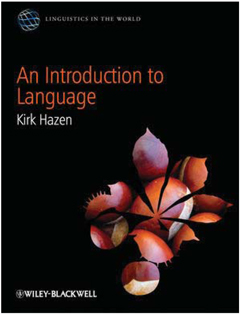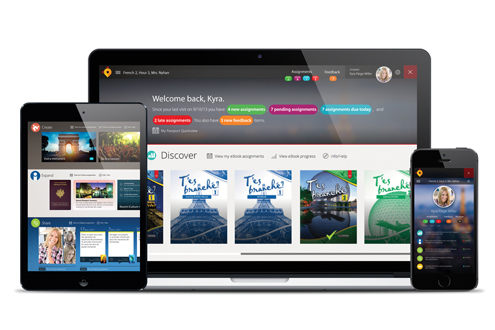How Does English Work?

Kirk Hazen, PhD, professor of linguistics in the Department of English at West Virginia University, believes everyone should learn about how language works.
His new book, An Introduction to Language, provides readers who have no background in linguistics with a tour of English and how language works in their lives.
“This is a process of self-discovery. If you go through this book, you’re going to learn things about yourself and what you do with language,” Hazen said.
The book includes exercises and examples that help readers explore the different levels of language. Hazen works from smaller parts, such as the individual sounds of language in the variation between birthday and bir[f]day, to the larger parts of language, such as the differences of phrases like pass me the ball and pass the ball to me. Some of these differences reflect social distinctions:
“While in some geographic areas the pronunciation [of birfday] goes completely unnoticed, in other regions, it might be seen as an indicator of lower class status. How it’s seen — and how it’s judged — depends on who’s using it,” Hazen said.
Hazen also takes readers on a tour of the history of English, including some phrases that have held strong through the centuries:
“Consider the saying dead as a doornail. That phrase is itself a single entry in our mental dictionaries. It has a specific meaning. It came to be back when doors had nails. You had to bend them over in the door to hold two slats together. Therefore, the nail was dead. You couldn’t reuse it.”
In An Introduction to Language, Hazen guides readers through the study of the language around them — as well as their own variations and impacts on it — by providing them with a new lens to examine their daily lives.
Hazen crafted the book for readers with no background in language study. By thoroughly explaining basic concepts with tangible examples, Hazen has avoided layers of linguistic jargon that could prevent readers from learning about one of the most beautifully complex skills we all possess.
Avant Upgrades Assessments
Avant Assessment has worked diligently over the past year to upgrade its core STAMP and Placement assessments for the K–16 field, and the technology that delivers and supports them. STAMP is the first fully online, adaptive assessment designed to measure real-world proficiency. STAMP (STAndards-based Measurement of Proficiency) was originally developed at the Center for Applied Second Language Studies (CASLS) at the University of Oregon. CASLS’s objective was to provide a valid and reliable measure of the levels of proficiency that language programs and students were achieving, so that teachers and administrators could identify how to improve student outcomes through targeted professional development or adjustments to the curriculum and instruction.
STAMP is available in two versions, STAMP4S for grades seven to adult and STAMP4Se for grades 3–6. STAMP assesses reading, writing, listening and speaking proficiency and reports scores in eight sublevels ranging from novice to advanced. Detailed and easily accessible reporting for individual classroom, building, and district levels for each domain is provided. Teachers can access individual student’s speaking and writing responses for up to four years, enabling longitudinal analysis.
Over the past year Avant Assessment has added STAMP4S assessments in English and Hebrew and overhauled their German, French, and Italian STAMP4S assessments. In addition, they have developed an innovative online, adaptive assessment of Arabic proficiency (APT) for native Arabic speakers in three grade bands (grades 3–5, 6–8 and 9–12). The APT is a fully monolingual test of Modern Standard Arabic that is being administered across the Middle East. Avant is building a line of assessments to meet the growing demand for Arabic language assessments in the region. STAMP4S is available in Arabic, Chinese (in both simplified and traditional characters), English, French, German, Hebrew, Italian, Japanese, and Spanish. STAMP4Se is available in Chinese (in both simplified and traditional characters), French, Hebrew, Japanese, and Spanish.
Muy Bien Spanish program
The Muy Bien Spanish program is a fun and comprehensive approach to teaching Spanish as a second language. The program offers much more than a textbook series: Muy Bien supplies educators with a bag of tricks, and yes, each level comes with a bag. In addition to the student activity books and student interactive CD, the Muy Bien Teacher’s Kits include books, picture cards, assessments, games, CDs, posters, and puppets. Muy Bien is recommended for K–8 and is available in five levels.
Levels A–C focus their content-based units on the world around the students. Level A delves into the basics, such as numbers, colors, family, body parts, food, animals, shapes, and school. Level A aims for word recognition, comprehension, and conversation. Level B goes more in depth with some of the topics covered in Level A, such as the family and the home, but also goes into the calendar and clock, along with other functional language. Level B also emphasizes low-level literacy. Level C goes deeper still into extended family, the school day, places in the city, and meals but also covers present-tense conjugations.
Levels D and E are more advanced, and each chapter is organized around a particular place. Level D focuses on a different Spanish-speaking country each chapter, while E also covers non-Hispanic Latin American countries, such as Brazil and Haiti, as well as the U.S. Level D introduces the past tense, while E, the most advanced level of Muy Bien, offers regular verbs in the future tense and irregular verbs in the past tense. As the content becomes more complex, activities also evolve to match the abilities and interests of the students. The advanced levels replace puppets and nursery rhymes with more complex games and songs to pique the interest of big kids.

Passport Learning Environment Debuts at ACTFL
Among the hot topics at this month’s American Council on the Teaching of Foreign Languages (ACTFL) conference in San Antonio are bound to be the future of world language learning and the new tools that will help students achieve proficiency. EMC Publishing is contributing to the conversation about what’s next by introducing Passport, its online environment for teaching and learning world languages in K–12, to the audience at booth #10031.
Built through a partnership between EMC Publishing, a division of New Mountain Learning, and the University of Minnesota’s Institute for Design Innovation (IDI), Passport marries IDI’s research-based language-learning platforms with EMC Publishing’s ACTFL-aligned instructional content. The tool taps into the innovative learning technologies that digital natives embrace to drive educator effectiveness and student achievement.
Dr. Charles Miller, associate professor of learning technologies and executive director of IDI, is presenting the plenary session at the conference alongside Christine Brown, U.S. Department of State, and Alvaro Roa Santamaria of Rackspace on Saturday, Nov. 22. The topic is “Framing Language Learning within the International Context of Global Competence: What Does It Take to Prepare Our Students for International Engagement?” The group will explore business demands for language and cultural capabilities and how to effectively prepare students to live, work, and study in the international arena.
Dr. Miller will also take part in “Design Innovation in World Language Discussion, Reflection, and E-Assessment” later the same day. That presentation will challenge teachers, researchers, and instructional designers to re-envision the value of technology-mediated feedback, discussion, and reflection opportunities by exploring the pedagogical foundations, integration, and research of two contemporary learning platforms: Avenue and Flipgrid.
On Friday, Nov. 21, attendees will be able to get hands on with Passport in a workshop. Participants will be able to see exactly how the program takes students on a culture-rich voyage, connecting them to EMC’s curriculum in and out of the classroom. They’ll be able to experience the authentic cultural videos, news, and songs and unique video collaboration and assessment tools that enable performance-based tasks and project-based learning. Passport is currently available for K–12 students studying French and Spanish in traditional, blended, or online classrooms. Chinese and German versions will follow in early 2015.
Jenny Lehman, the assistant superintendent of the Upper Moreland School District in Pennsylvania, believes that to succeed beyond high school students must be capable of participating in the 21st-century world. Lehman’s district recently adopted Passport. “Our development of a scope and sequence and planned courses in our world language program requires our students to gain an increased level of communicative proficiency at each level of the language, as defined by ACTFL standards. We just started using Passport, and it is amazing. Never before have students been so involvedin , accountable for, and recognized for their learning.”
EMC Publishing will also be providing a workshop on its new five-level Spanish program, ¡Qué chévere! The program delivers language and culture submersion experiences in a blended learning environment where text and technology are seamlessly integrated to engage students and enhance learning.

Practice Spanish: Study Abroad in 3–D from Your Living Room
In partnership with the award-winning video-game developer Muzzy Lane Software, McGraw-Hill Education has created the first immersive 3-D language game for introductory Spanish learners, to be used in the classroom or as an independent practice tool. Students “travel” virtually to Colombia, where they will problem solve, communicate, and navigate through a variety of cultural scenarios and adventures as they “study abroad” in a fictional Colombian town. Students will earn points and rewards for successfully accomplishing these tasks via their smartphones, tablets, and computers, while instructors will have the ability to assign specific tasks, monitor student achievement, and incorporate the game into the classroom experience.
Practice Spanish: Study Abroad provides students with extensive and meaningful language practice outside the classroom experience, actively engaging, and motivating students to explore the Spanish language in real-world cultural settings while having fun using their developing language skills to complete practical, day-to-day activities. Students can design their own avatars, selecting physical features to their liking, including hairstyle, eye color, and clothing. Players may then interact with game characters as they complete assigned tasks: for example, they may be asked to find their classes on campus, plan weekend excursions, buy souvenirs, interact with fictional host families, or even seek medical attention to assist a classmate.
The program consists of twelve “quests” to be completed over the course of a typical first-year language program. Each real-world task or virtual experience is preceded by a series of short mini-games focused on the necessary vocabulary and grammar to play the game and earn points or rewards. These pre-task mini-games must be mastered in order to “unlock” the full virtual experience, ensuring that all students demonstrate a degree of core competence before playing each quest.
Student performance will be measured by the ability to successfully complete the quests while also maximizing avatar achievement across four key variables: money, time spent, wellbeing, and language accuracy. Each student experience will be unique, as students will be asked to make individualized choices that will lead to differing paths and experiences as they accomplish their tasks. Students can play the game as many times as they like to uncover new challenges, opportunities, and experiences.
Practice Spanish: Study Abroad can be played online or via mobile apps in iTunes and Google Play. www.mhpractice.com
Mustering Math Skills in ELLs
DreamBox scores a hit in two languages
Learning the language of math in English can be challenging for English language learners (ELLs). Many of these students are learning both the English language and mathematical concepts simultaneously, struggling with vocabulary or syntax, and teachers often do not have the resources to adequately help students who might be experiencing language-related challenges.
It’s critical that all students have the support and opportunities to acquire the skills needed to succeed not only in math but also in life. DreamBox Learning delivers personalized learning paths that motivate and guide all levels of learners, regardless of where they live or whether English is their first language, to achieve math proficiency. Combining their Intelligent Adaptive Learning technology with a rigorous mathematics curriculum, the program provides a motivating learning environment for the students. Additionally, DreamBox Learning has incorporated Spanish language into its current pre-K–8 math curriculum this fall. The new Spanish-language option aims to empower teachers with support for dual immersion and ELL implementations to control language settings and toggle between English and Spanish while providing 24/7 access to extend learning beyond the school day with curriculum that builds conceptual understanding and procedural fluency. DreamBox invites all students into an engaging, age-appropriate, and motivating learning experience that challenges students to demonstrate their learning.
With lessons now offered in Spanish, DreamBox Learning has further removed language roadblocks to learning math for ELLs, adding Spanish voiceover within lessons, with each element carefully evaluated by student focus groups and lengthy consultation with Spanish-speaking teachers to ensure that the experience is culturally appropriate and relevant for native Spanish speakers. For students, all content and user experiences will be fully available in Spanish to help every student realize a deeper understanding of and life-long confidence in math.
Blüten in Berlin?
Due to popular demand, GamesforLanguage.com is adding a German 2 course. In this sequel to the German 1 course, Michael Mueller, a young traveler, returns to Berlin, where he is faced with a baffling mystery. After he is caught attempting to pay with a counterfeit euro note (blüte in German jargon), he sets out to find the young woman who had slipped him the note on the plane from Boston to Berlin.
By playing dynamic games while following a mystery narrative, users are motivated to learn by the fun of it. To solve the mystery of the blüte, they must collect enough points to move on to the next scene. They thereby learn and practice real and useful German phrases and sentences, which — because of the engaging story context — they’ll remember.
All lessons begin with a story dialog. The sentences are then broken down into their component words and phrases, which players practice in various games. Finally, players are prompted to reassemble the sentences from the dialogue. A Say It sequence emphasizes the importance of repeating and speaking words and phrases. With games like Word Invaders or Shoot Out, players practice translations and word order. Word Hero and Shooting Gallery games help recall the vocabulary of previous lessons. Record It then lets learners record the story lines themselves and practice their pronunciation.
GamesforLanguage’s courses (German, French, Italian, and Spanish) are all online and free. Courses and Quick Games are accessible on most tablets.
Finnish Program promotes Netiquette and Online Literacy
Petra’s Planet teaches proper netizenship
Petra’s Planet for Schools, developed in Finland, is a motivating and student-centered online learning environment that helps schools affordably teach important digital- and social-media skills to children aged five to twelve.
This unique solution opens up a safe environment where young students can learn critical digital skills and etiquette, also called netiquette, under their teachers’ guidance, as part of any subject.
Petra’s Planet for Schools helps children learn how to relate to others through the virtual environments that are such a key aspect of modern life. It also ensures that the most important social skills for the digital world can be easily taught in a fun and engaging way.
Created in collaboration with Finnish teachers, Petra’s Planet for Schools provides students with a range of engaging activities for online social and community-centered skills, such as simplified email, chat, and multiplayer games.
New features such as a blog and the possibility of finding a sister class — which offers students the opportunity to connect with a class in another school, anywhere around the globe — help teachers to develop communication, collaboration, and creative skills in their students. At the same time, partnering with twin classes and sharing blog entries with them helps the students to gain a sense of global cultural awareness and, with their teachers’ guidance, allows them to share ideas and content. Teachers can sign up for free access online.
Children Should Be Seen AND Heard
Language ranks as one of the most critical skills a young child must develop to have future success in school. Specifically, the first three years mark the most intense period in language learning, a time when a child’s language foundation is built.
Published by the award-winning Gryphon House, Inc., the newly released book Raising a Talker provides practical communication and language information and advises parents and caregivers how to play and talk in ways that foster children’s emerging language skills. The activities build on children’s natural curiosity and their desire to interact with caring adults.
Research-based tips and developmental overviews are provided by author Renate Zangl, PhD, a developmental psycholinguist who has more than 15 years of experience researching early language learning and working at different research institutions in the U.S. and Europe, including Stanford University; the University of California, San Diego; Graz University, Austria; and Laboratoire de Science Cognitives et Psycholinguistique, Paris.
Zangl combines her insight with fun, easy-to-do activities that help parents and caregivers naturally transform play sessions into meaningful language-learning experiences. The book features 50-plus hands-on activities, language checklists, communication tips, developmental milestones, and early warning signs for children from birth to three years old. These activities follow the progression of language development from the child’s first smiles and coos to first recognizable words, then to experimenting with words and saying actual sentences.
Raising a Talker will have parents and caregivers more tuned in to young children as conversational and play buddies. Little tweaks and easy changes in everyday play create nurturing environments where communication and discovery can flourish. These skills build the foundation for better communication, both now and later, and set the stage for success in school and beyond.
Raising a Talker
Renate Zangl, PhD
Gryphon House, Lewisville, NC
Paperback, 216 pages. $19.95
ISBN: 978-087659-473-5
Editor’s Pick: Games That Get Them Talking
Games can really bring your language class to life, so what better way to learn than an interactive journey around Spain? KLOO Cards and the KLOO board game, Race to Madrid, offer communicative activities that encourage learners to think about sentence construction in Spanish.
KLOO Cards are decks of cards that can be used to play a competitive game in which players form sentences in Spanish with their cards. KLOO assures players that even a total beginner can form a grammatically correct sentence in less than a minute by following the instructions on each card — and there are thousands of possible sentences to choose from.
To play, the cards are dealt out to each player, who will then use the color-coded cards and arrows to form sentences. A beginner with no knowledge of the Spanish language could successfully form a sentence following the color-coded instructions. For example, nouns are blue cards and adjectives are yellow cards, and each card has colored arrows revealing which other cards could then come next in the sequence. KLOO aims to build the players’ vocabulary during the game, so each card displays the pronunciation of the word or phrase and reveals the meaning of other related words to help foster discovery-based learning. Once a player has successfully created a sentence, he or she is awarded one point per card. The player with the most points wins the game.
KLOO cards are not just for classroom language students; they can provide fun for friends or families trying to learn Spanish and are recommended for ages seven and up. Inside the classroom, however, the game is a rewarding way for students to engage with and interact in Spanish, even at a beginning level. Simultaneous games can be played in the classroom, and teams or groups can be created if each has their own deck.
Race to Madrid, the board game, includes four decks of KLOO cards and a vibrant game board — complete with little cars to identify each player’s place in the game. Players race through beautifully diverse Spanish cities before arriving in Madrid. The rules are similar to the KLOO Cards game, but instead of tallying their scores, players move their cars one square per card after successfully making grammatically correct sentences. Special squares marked “Hotel” or “?” can make the game more interesting by asking players to challenge each other to define words. The game can also be modified to the time constraints of the players and can easily be shortened or extended.
Both KLOO Cards and the Race to Madrid board game can be added to any language-learning program or revision session for some lighthearted laughter and educational fun. Sentences are always grammatically correct — but occasionally the sentence results can be quite silly, adding to the fun and inspiring players to be creative. KLOO games are also available in French, Italian, and English and add an engaging and interactive element to language learning. — Athina Kontos
Spanish Now!
Barron’s popular Spanish Now! series offers comprehensive texts that combine with CDs to hone reading, writing, listening, and speaking skills in Spanish. Spanish Now! uses puzzles, illustrations, and cartoons to make learning fun and engaging, while infusing lessons with Hispanic culture. The books are divided into six parts made up of content-based listening focusing on structures and verbs, topical vocabulary, idioms and dialogues, skills in listening comprehension, skills in reading comprehension, and skills in writing. Each work unit presents scenarios, featuring Hispanic characters, that relate to the linguistic goals and theme of the lesson.
The series affords self-directed learners many opportunities to accomplish much on their own and dedicates quite a lot of space to focusing on writing skills and structures. Many of the grammatical explanations and instructions are written in English. It can easily be used in a communicative classroom setting as well. The first two levels take students through most of Spanish grammar and conquer the subjunctive tenses. Spanish Now! is a strong series for either independent Spanish students or classes. www.barronseduc.com
Spanish Community Interpreting Certificate
California’s Monterey Institute of International Studies is now offering a graduate certificate in Spanish community interpreting. This Spanish-English professional certificate is designed as a hybrid, low- residency, six-month program. Training begins with an on-site, four-week module in Monterey in January, continues with an online module throughout the spring, and culminates in a seven-week summer module back in Monterey. The final component of the program includes a week of intensive preparation for medical and court certification exams. Ideal candidates have a BA, and strong bilingual and bicultural skills and are interested in using their language and cultural backgrounds as community interpreters in legal, medical, social service, and educational environments.
The curriculum offers participants a solid foundation in written translation, sight translation, consecutive dialogue interpreting, and simultaneous interpreting. Participants will build professional and linguistic knowledge needed for the fields of legal, medical, social service, and educational interpreting and will be prepared to take court and medical certification exams. The Monterey Institute’s state-of-the-art interpreting lab facilities enable participants to develop their professional skills with extensive individual feedback.
Participants who complete the certificate will find themselves eligible for many freelance or staff positions at courts, law firms, hospitals, clinics, school districts, and other public service centers.
Holly Mikkelson, the faculty advisor for the program, is an associate professor of translation and interpretation at the Graduate School of Translation and Interpretation, Monterey Institute of International Studies. She is an ATA-certified translator (S>E, E>S) and a federal- and state-certified court interpreter who has taught translation and interpreting for over 30 years. She is the author of the Acebo interpreter-training manuals as well as numerous articles on translation and interpretation in the court-, medical-, and community-interpreting fields, and is a co-author of Fundamentals of Court Interpretation: Theory, Policy and Practice.
Visit go.miis.edu/communityinterp for more.



